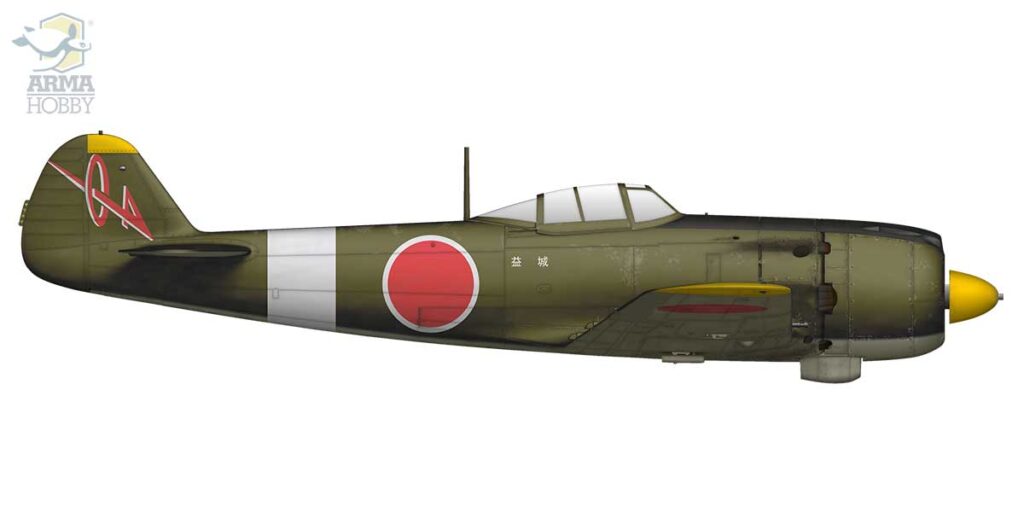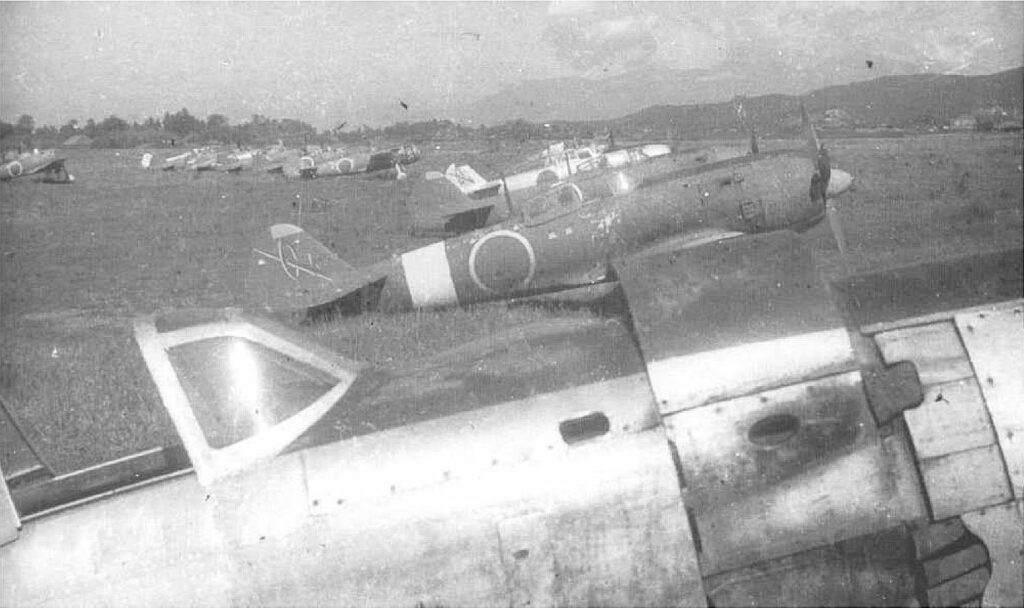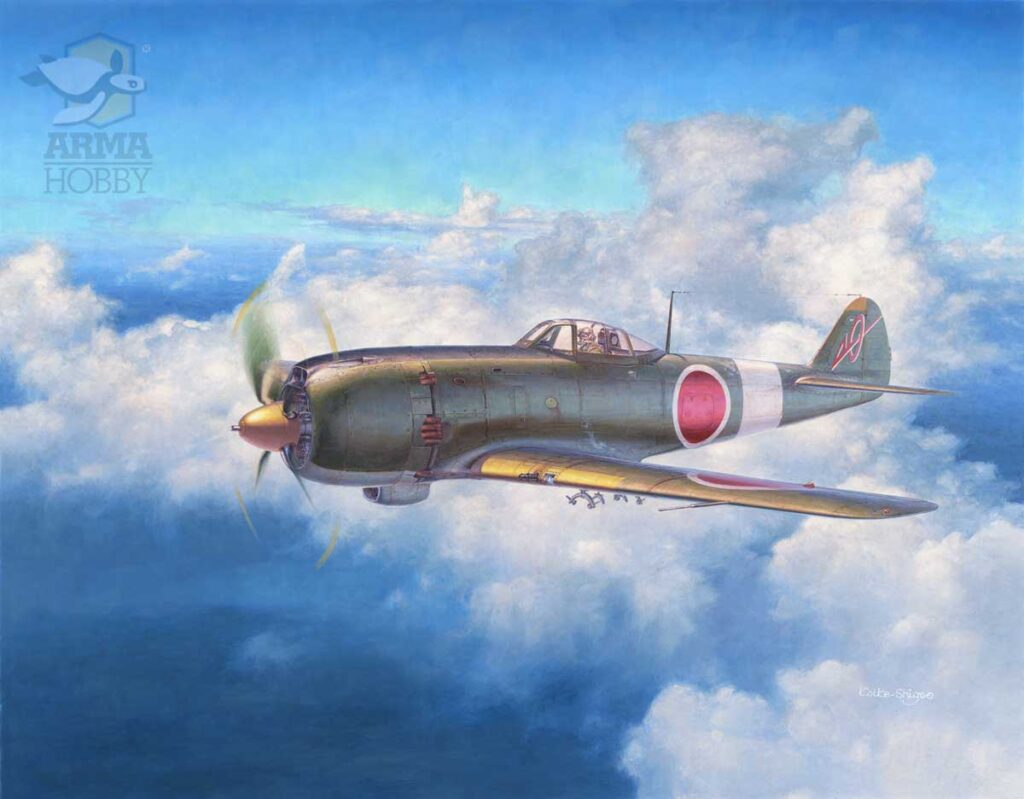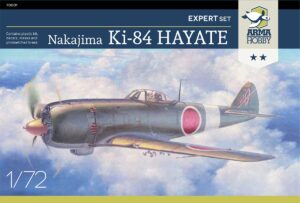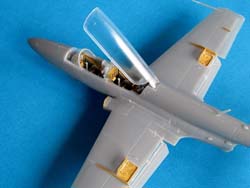The Ki-84 Hayate (Gale), Allied reporting name Frank, was one of the most widely used and best recognizable Japanese fighters of the Second World War. It is well known both to those who are interested in the history of the air war over Asia and the Pacific, and to modellers. The Otsu version was an immense rarity. This variant of the Gale was intended for combatting heavy bombers, and therefore had stronger armament than the standard Ki-84 Ko. In the Otsu, the 12,7 mm Ho-103 fuselage machine guns were replaced with 20 mm Ho-5 cannons (the same as were fitted in the wings). Externally, the new version was not much different from its predecessor. The sole visible modification were the larger and differently spaced exhaust gas discharge openings for the fuselage cannons.
The appearance of Captain Tomiya’s aircraft is well known thanks to a few photos taken in August 1945 at Ota airfield in Japan shortly after the suspension of hostilities. The photographs, which were made by a physician at Ota, present the Hayate in the company of three other aeroplanes of 104th Sentai.
The story of 104th Sentai is a clear reflection of the operational and organizational problems that crippled the Imperial Japanese Army Air Force (IJAAF) in the final year of the war. It also provides an insight into the aerial combat that took place in the relatively less well known theatre of the borderlands of northern China, Mongolia and the Soviet Union.
Manchuria – A Historical Background
In order to properly understand the historical realities of the region, it is necessary to answer the question as to how important Manchuria actually was for the Japanese Empire.
 Historically, relations between Japan and the inhabitants of continental Asia were both turbulent and complicated. The first formal period of Japanese overlordship over the lands of north-eastern Manchuria occurred following the end of the Russo-Japanese War of 1904–1905, when they were handed over to Imperial Japan as a part of reparations. However, these lands formed only a small part of the province which itself soon gained vital importance for the Japanese. There were numerous reasons for their interest. First of all: the home islands were becoming overpopulated and desperately needed new lands to settle. Secondly, the province had a wealth of raw materials and minerals, which were necessary to fuel the development of the Japanese “industrial revolution”. Thirdly and finally, the region could function as a bridgehead for continuing the rivalry with the Empire’s primary opponent, China. For these reasons, the area of Japanese Manchuria was subjected to rapid ethnic and economic expansion, while later a special land force, known as the Kwantung Army, was established to formally protect Imperial interests.
Historically, relations between Japan and the inhabitants of continental Asia were both turbulent and complicated. The first formal period of Japanese overlordship over the lands of north-eastern Manchuria occurred following the end of the Russo-Japanese War of 1904–1905, when they were handed over to Imperial Japan as a part of reparations. However, these lands formed only a small part of the province which itself soon gained vital importance for the Japanese. There were numerous reasons for their interest. First of all: the home islands were becoming overpopulated and desperately needed new lands to settle. Secondly, the province had a wealth of raw materials and minerals, which were necessary to fuel the development of the Japanese “industrial revolution”. Thirdly and finally, the region could function as a bridgehead for continuing the rivalry with the Empire’s primary opponent, China. For these reasons, the area of Japanese Manchuria was subjected to rapid ethnic and economic expansion, while later a special land force, known as the Kwantung Army, was established to formally protect Imperial interests.
Manchuria – an old print showing the Russian-Japanese 1905 war theatre
The latter development, although logical, turned out to be somewhat unfortunate. The young, obstreperous officers of the Kwantung Army supported the idea of expanding the Empire with great enthusiasm right from the start, and commenced intensive planning for further territorial conquests. Their objective was to occupy the whole of Manchuria (to begin with). Although this stood in contradiction to the then doctrine of the Japanese authorities, the problem was that the commanders of the Kwantung Army were not particularly interested in the directives of the national administration, and even disobeyed orders given by the Imperial General Headquarters. At the turn of the 1930s, China’s international standing was considerably weakened by the conflict between the Communists of Mao Zedong and the Kuomintang of Chiang Kai-shek. In September 1931, officers of the Kwantung Army staged a false flag event (known as the Mukden Incident) which was presented as an attack by the Chinese Army on a railway line used to ferry Japanese troops. The entire operation (to put it simply) served as a pretext for the Japanese Army to take over most of Manchuria. In order to legalize its gains, the Empire established a puppet state, Manchukuo, under the leadership of Emperor Puyi. Needless to say, the rise of militaristic and expansionist sentiment in Japan during the 1930s resulted in Manchuria being viewed as a “jewel in the crown”. The territory was secured both politically and militarily, and its economy developed rapidly (mainly thanks to the efforts of the Japanese themselves), while its distance from future areas of combat operations allowed it to function as a strong and relatively peaceful economic base of the Empire. The situation changed, however, in mid-1944, and this leads us directly to the story of 104th Sentai.
Map of the territories controlled by Japan in 1939 with the puppet Manchukuo state created in Manchuria
104th Sentai – Difficult Beginnings
The first serial-produced Hayates were sent to units operating in the CBI (China-Burma-India) Theatre. Among them were the renowned 25th, 50th and 85th Sentais. Successive fighters were handed over to operational training stations and units based in the Philippines. In the summer of 1944, it was decided to create four completely new groups, all equipped with the Ki-84. These were the 101st, 102nd, 103rd and 104th Sentais, which were ultimately intended for service with the Japanese Homeland Air Defence (Hondo Boei Butai). Things turned out differently, however, as the first three gained distinction while flying costly escort missions for kamikaze units during the fighting for Okinawa. Whereas the development of their “younger sister” stalled completely due to a lack of both aircraft and personnel (pilots and ground crews).
104th Sentai was officially established by an order dated 15 August 1944, and stationed at Ozuki airfield (which is used intensively to date by the Japan Maritime Self-Defence Force (JMSDF)). It was placed under the command of Major Yamato Takiyama, who received six (!) more or less experienced pilots from 4th Sentai and … one mechanic. This whole “unit core” was soon sent to Ota, a base that functioned in part as the factory airfield of the Nakajima plant, and in part as an operational training centre of the IJAAF. It was here that the Sentai was to receive new aeroplanes and additional personnel, and also conducting training. But the Imperial General Headquarters, pressured by General Itahana, the commander of 2nd Air Army (2 Koku-gun) in Manchuria, decided (barely one week later) to send the unit to the base near Mukden. Let us just keep in mind that at the time the group was de facto non-existent. The reason for the decision was, however, important: Manchuria’s industrial infrastructure (for the first time since the outbreak of war) had found itself within range of American B-29 Superfortress bombers operating from bases in India and China under Operation Matterhorn. Towards the end of August there was a truly bizarre development when a lone Ki-43-II Hayabusa landed at the airfield in Mukden (present-day Shenyang). The aircraft, showing signs of considerable wear and tear, had previously been operated by one of the schools in Ota; Major Takiyama begged that it be sent to his unit, and, once permission was granted, flew it over personally. The remaining personnel of 104th Sentai stayed in Ota, where they awaited the promised Hayates and fresh flight and ground crews.
Four 104th Sentai Hayates which managed to return to Japan on 15th August. Photo made on the Ota airfield just after the cease-fire. Second in the row is the Ki-84 Otsu, Cpt. Mitsuo Tomiya’s (2nd Chutai commander) personal plane with Japanese letters meaning “Mashiki” on the fuselage in front of the Hinomaru marking. Next Hayate (also from the 2nd Chutai) has the unit marking painted without the white outline, which makes it almost invisible on the black-and-white photo. 1st and 4th planes on this photo have markings in red, meaning that they belong to the 1st Chutai.
A fully-equipped single-engined fighter Sentai should have comprised at least three Chutais, at minimum 42–48 aeroplanes, and nearly 350 personnel. Shocked to have received “support” in the form of one aircraft and a single pilot, General Itahana had no choice but to organize a bare minimum of aeroplanes and men for 104th Sentai on an ad hoc basis. In this way Major Takiyama entered into possession of a few Ki-43 Hayabusas and Ki-44 Shokis, six pilots, and a dozen mechanics. The soldiers, who were in the main Japanese born and raised in Manchuria, were transferred from various units of the Manchukuo Imperial Air Force.
104th Sentai in Battle
Although at the turn of September 1944 the 104th Sentai was completely underequipped, it was pressed into battle when the Superfortresses of the 58th Bombardment Wing, stationed in China, targeted Manchuria’s industrial infrastructure. The first raid took place already on 8 September. A pair of Ki-44s flown by Major Takiyama and one of his young subordinates raced to the attack. However, the Japanese reconnaissance and direction-finding system was in a state of such disarray that the two pilots completely missed a formation of nearly 90 Superfortresses. But the Americans also let things slide, as they dropped their deadly cargo within a distance of 3 to 11 (!) km from their targets. The second encounter took place on 26 September, and six Shokis led by the Major reported damaging one B-29 without any own losses. This was the unit’s first success, and in addition complete (although the Japanese did not know this), for while the crew of the damaged bomber escaped more or less unharmed, the aircraft was a total write-off after crash-landing at its home base.
In November 1944, the group finally received two Hayates, a dozen or so young pilots and the same number of mechanics, all brought in from Japan by Captain Tomiya. Work immediately started on familiarizing the crews with the new fighter, while after completing their training pilots were sent back home to fly over additional Ki-84s. Before the end of the month, the combat component comprised twelve Ki-84s and approximately twenty Ki-44s. Four Hayates were assigned to the group’s headquarters section, and 1st and 2nd Chutai received four further Ki-84s and Shoki fighters. 3rd Chutai, equipped with ten to eleven Hayabusas, temporarily served as an operational training squadron and was not used to combat the B-29s. At more or less the same time, an order was received to form an aerial ramming section (Shinten Seiku-tai). This instruction was addressed to nearly all units of the Japanese Homeland Air Defence, and so 104th Sentai also established such a section; named the Kikusui-kogekitai (chrysanthemum attack unit), it comprised three Ki-44s and one Hayabusa. In accordance with the tradition of ramming units, the aircraft received their own markings separate from the emblem of 104th Sentai. In English-language literature, the symbol known as ken is described as a sword. In reality, this well-known Japanese weapon with a short, wide blade, is the equivalent of a sword, or rather a battle cleaver – the traditional weapon of Korean pirates who had for centuries roamed the waters off Japan.
December 1944 brought with it fresh bombing raids carried out by the 58th Bombardment Wing, and also two of the largest aerial battles to take place in the skies above Mukden. The first took place on 7 December, when nearly 120 American bombers ran into six Hayates and twelve Shokis from 104th Sentai, supported by a smaller group of fighters from 25th and 81st Dokuritsu Chutais (Independent Squadrons) and a few aircraft of the Manchukuo Imperial Air Force. The defenders secured a rousing victory, and reported shooting down no less than fourteen B-29s. This loss practically ended the mission, for although the American bombers maintained formation, the crews lost their cool and all bomb loads were dropped on a field many kilometres before the target. The 58th Bombardment Wing confirmed the loss of seven aeroplanes, of which four were stated as having fallen prey to Japanese fighters, while three purportedly “crashed on the return route as a result of mechanical failure”. It is however highly probable that these “mechanical failures” were the result of damage sustained in combat. The pilots of 104th Sentai claimed a total of nine “kills”, of which two – one confirmed and one probable – were achieved by Major Takiyama; another victory was awarded to Captain Tomiya. Sergeant Major Nagata (a pilot from the aerial ramming section) died while destroying B-29 “Humpin Honey” (serial number 42-6299) from the 462nd Bombardment Group. Sergeant Akeno, whose aircraft disintegrated in the air after being hit by enemy fire, was another who perished in the battle. The next encounter, which took place on 21 December, was basically a carbon copy of the first. Fighters from the defence forces of Mukden reported a total of five victories (of which 104th Sentai claimed two), while the Americans bombed a field long before arriving over their targets, losing two aircraft. It would appear that on this occasion the claims made by 104th Sentai were exaggerated. One of the Superfortresses was effectively rammed by Lieutenant Matsumoto (a Japanese aerial combat instructor serving in the Manchukuo Imperial Air Force), while the other exploded after being hit by Sergeant Akiyama, a Ki-46-III pilot from 81st Dokuritsu Chutai stationed at Otsu.
This battle closed the chapter of the 104th Sentai’s fight with the “silver beasts”. At the beginning of 1945, the 58th Bombardment Wing was moved to Saipan, Guam and Tinian in the Mariana Islands, where it joined the newly formed 73rd Bombardment Wing in missions against the Japanese home islands. In spite of technical and organizational problems, 104th Sentai acquitted itself well of its tasks. The B-29 bombing campaign targeting the industrial centres of Manchuria turned into a complete fiasco (as did nearly all other campaigns conducted by the 58th Bombardment Wing from bases in China). Although their success was not spectacular, the Japanese fighters achieved their primary goal. The unit continued to grow, waiting for the development of events.
104th Sentai – The End
During the spring of 1945, the group’s strength increased sizeably. Finally, it began to receive a steady stream of factory-new Ki-84s, while the aircraft which it had hitherto used were temporarily sent to Japan for overhauls and repairs. Senior pilots gained flight-time and experience, and could act as instructors for their younger colleagues. The group flew on numerous patrols and training exercises, the latter made possible mainly by the fact that Manchuria had ample stocks of fuel and spare parts (shortages of which were felt very acutely in Japan). Estimates indicate that at the time the unit had some forty to fifty Hayates and twenty to thirty Shokis (plus a certain number of Hayabusas in reserve). But this “fresh and shiny” might of 104th Sentai had no foe against whom to pit itself. The American bombers, moved to the Marianas, were attacking targets directly in Japan, Allied carrier-borne fighters were fighting for Okinawa, and aerial combat was also taking place in Burma and southern China – but the skies above Mukden were deathly quiet. This situation continued until nearly the end of the conflict. Nearly, because on the day when the atomic bomb was dropped on Nagasaki, the Soviet Union declared war on Japan while at the same time completing the concentration of its armies in the USSR and Mongolia, close to the Manchurian border.
1st Chutai aeroplane – visible on the previous photo as 4th in a row.
On 12 August, twenty-five pilots of 104th Sentai took off in their Hayates equipped with additional fuel tanks and 250 kg bombs, and set course for Linhsi (Inner Mongolia). However, the result of their attack on Soviet army columns is difficult to determine. Soviet sources have “elegantly” passed over the topic, while the Japanese fliers (trained for interception missions, not for fighter-bombing) were on the whole unable to give a proper assessment. On 14 September, when the weather conditions in the area rapidly deteriorated, the Soviets were attacked by only five Hayates, and by twelve the next day. Two aircraft together with their pilots were lost in the assaults. The commander of 1st Chutai was shot down by ground fire and perished in the wreck of his Ki-84. Sergeant Tetsuo Kataoka was another who did not return from the mission; he was considered missing in action. In all probability, the pilots did not encounter the Soviet Air Force. The sole flier who reported a confirmed kill at this time in this area was the Soviet ace Captain Sirotin. He reportedly attacked a pair of single-engined enemy fighters and, using the cannons of his Kingcobra P-63, ripped one to shreds. Although he was unable to specify the type of the enemy aircraft, he mentioned that it had strange, colourful markings. We may therefore assume that it was a fighter of the Manchukuo Imperial Air Force, probably a Ki-43 Hayabusa (Manchukuo had Ki-43 and Ki-27 Nate fighters, but the latter had been well known to the Russians since the summer of 1939, when they fought against them over Khalkhin Gol).
The ground assault mission of 12 August brought one thing home to the Japanese – that Manchuria was doomed. There was nothing to oppose the forces gathered by the Soviets (in fact, the once mighty Kwantung Army was routed within just 12 days). Thus, plans were made to withdraw 104th Sentai to Japan, where it would take part in fighting off the inevitable (as everyone then thought) American invasion. But only four Ki-84s, led by Captain Tomiya, managed to accomplish the feat. This explains how the photograph was taken in Ota just after the suspension of hostilities. Before imposing a complete flying ban on Japanese aircraft (or even shortly after its introduction), some of the aeroplanes were probably sent to Korea and eastern China. The Red Army captured only ten airworthy Hayates of 104th Sentai. But since the USSR was not interested in conducting tests of the Ki-84, the aircraft were soon gifted to the country’s “friends” from the People’s Republic of China.
104th Sentai Ki-84 Hayates on the Anshan airfield shortly before the Soviet Army arrival. Manchuria, August 1945.
Paint Scheme and Markings
Ki-84s usually left the assembly line in one of two marking variants, namely in the natural metal colour or in a two-coloured camouflage scheme comprising grey-green Nakajima colouring on the undersides (approximate equivalent FS 34373) and olive-green (approximate equivalent FS 34098) or dark green (approximate equivalent FS 34095) on the upper and side surfaces. The choice of green depended not so much on the period of the war as on the current availability of paints, and therefore on the promptness of deliveries made by subcontractors. We can have no absolute certainty as to the paint tones used on Captain Mitsuo Tomiya’s aircraft, however the majority of researchers is of the opinion that it would have been lighter, i.e. olive-green. During the final months of production there were also Hayates painted in muddy-brown/mahogany, however none were sent to 104th Sentai.
A separate issue concerns the markings designating specific Sentais (groups) and their Chutais (squadrons), as well as individual pilots. The basic distinguishing feature was the emblem of a given Sentai, which was painted on the vertical stabilizers of its fighters. Usually each Chutai was assigned an identification colour that was used to paint the emblem of its Sentai on vertical stabilizers. This system was not, however, firmly grounded in regulations/orders of the IJAAF, but rather constituted a more or less commonly followed practice. In 104th Sentai, markings were affixed according to a somewhat different scheme. The unit’s emblem was an arrow penetrating a shield; the arrow itself resembled the number “1”, while its head was a stylized “4”, and the shield was a “0”, all of which together were a clear reference to the Sentai’s number. However, unlike the majority of IJAAF units, the emblem of 104th Sentai was painted exclusively in red or red with a white edging (a white “shadow”). Affiliation to a given Chutai was denoted by a specific colour, but this was applied only to a fragment of the upper section of the vertical stabilizer, the wing edges and the propeller spinner. These are the elements that are visible on Captain Tomiya’s fighter: yellow surfaces denoting affiliation to 2nd Chutai and the red emblem of 104th Sentai with a white “shadow”. In 104th Sentai, the broad white stripe on the fuselage was used to mark the aircraft of squadron commanders.
Nakajima Ki-84 Otsu (Ki-84b) – the personal aircraft of Captain Mitsuo Tomiya, the commander of 2nd Chutai (squadron), 104th Sentai (group) stationed in Manchuria. Artwork by Koike shigeo
The final graphical detail typical of aeroplanes from this unit were the ideograms (one or two kanji symbols), which were painted on the fuselages of the Hayates before adoption of the Hinomaru. On our aircraft we can see the white inscription 益城 (it was probably painted only on the right side), which stands for Mashiki – the name of Captain Tomiya’s home city.
English translation by Maciek Zakrzewski
See also:
- Order the Ki-84 Hayate model kits in Arma Hobby
A lover of strong coffee and dark chocolate, incurable optimist, romantic and dreamer, economist by education, historian and modeller by passion. From time immemorial he has been fascinated with aviation in every variety and form. For many years, he has been paying special attention to all aspects of the activities of the Army and Navy Aviation of the Land of the Rising Sun.
This post is also available in:
 polski
polski


